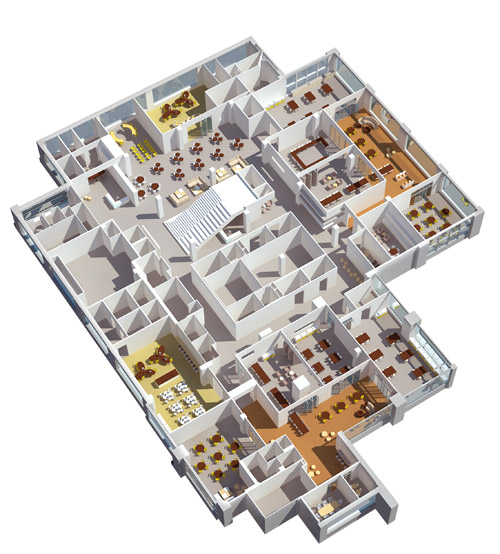Thematic High Schools: 10 Design Tips to Consider
 As school districts continue to look at new ways to engage students with a wide range of learning styles, one new model being considered is the Thematic High School. Career Technical Education is one example of a Thematic High School, but there are others as well. Thematic High Schools can consist of Career Technical Academies, Arts and Music Academies, Science and Technology Academies, College Prep Academies, or any number of targeted themes. There are specific differences between each of these, which can affect design decisions such as learning space requirements and characteristics, and furniture and equipment requirements. For example, an Art and Music Academy would have some very different spatial and equipment requirements than say a Science and Technology Academy.
As school districts continue to look at new ways to engage students with a wide range of learning styles, one new model being considered is the Thematic High School. Career Technical Education is one example of a Thematic High School, but there are others as well. Thematic High Schools can consist of Career Technical Academies, Arts and Music Academies, Science and Technology Academies, College Prep Academies, or any number of targeted themes. There are specific differences between each of these, which can affect design decisions such as learning space requirements and characteristics, and furniture and equipment requirements. For example, an Art and Music Academy would have some very different spatial and equipment requirements than say a Science and Technology Academy.
Despite these differences, there may be more characteristics that are shared by all Thematic High Schools than there are differences. Thematic High Schools tend to be smaller than comprehensive high schools and are usually considered a type of small learning community, which could exist as a stand alone school or as a “School within a School.” In this case, we are speaking of stand alone schools.
A typical Thematic High School might support 1,200 students, more or less. They tend to draw students from throughout a district and typically embrace some type of project-based learning. The goal is to provide stimulation and inspiration to students who have a particular interest in the school’s theme. The hope is that this level of specific interest and stimulation will help to inspire each student to perform at a level leading to successful matriculation to a four-year college, or post-secondary training, leading to a rewarding career. The purpose is to create a mode of education that is relevant to all students.
Keys to success of a 21st Century Thematic High School design process:
 The team should develop a broad understanding of the educational goals of the new Thematic High School.
The team should develop a broad understanding of the educational goals of the new Thematic High School.- Specialized instructional goals are to be understood by the design team, and supported by the new facility, while also providing for future flexibility.
- Project-based learning activities and 21st Century educational goals may call for support of more interactive functions, as well as support of individual, small, medium and large groups. Interactions may occur in formal settings as well as informal ones and can occur indoors and outdoors. Spatial consideration should go beyond a program checklist and every space, including circulation spaces, should be considered for the ability to support learning functions.
- Project-based learning activities may require specialized furniture and equipment. These should be considered early in the planning process so they can be supported by technology, utilities, and access and/or removal issues can be considered.
- The design of Thematic High Schools will encourage interaction with community, industry and educational partnerships with institutions of higher learning, to encourage student engagement.
- A Thematic High School will be serving students from multiple geographic locations within the district, so the varied modes of student transportation should be considered and supported.
- When converting an existing facility, existing spaces need to be understood relative to their ability to support the functions of the school, in addition to an understanding of their current condition, seismic performance, code status, etc.
- A Thematic High School welcomes and engages parents and families in the education of their students through its clarity of circulation, way finding, and creating a clear and welcoming single point-of-entry to the campus. There are design considerations that can occur within almost any existing program without changing the size or quantity of space require.
- The appearance of a Thematic High School should communicate its “brand image” at every opportunity. The inclusion of ample ways to display and highlight the work and achievements of students will enhance student pride and ownership of the campus, but also help build community pride and support for the new mission of the school in their community.
- A truly integrated approach to design will lead to better, more supportable outcomes. Include district stakeholders (i.e., teachers, students, parents, community members, and maintenance and operations personnel), builders, engineers and architects in an interactive process from the very beginning. Make sure educators are front and center in the process so that all the decisions are made with shared goals mind.
While Thematic High Schools typically provide spaces and equipment in support of certain highly specialized curricula, it is important to remember that they all support state curriculum requirements and the requirements of four-year, post-secondary institutions—in the case of California schools, this would be University of California admission requirements. Thematic High Schools, including Career Technical High Schools, are useful and efficient pathways to higher education. Questions on how to get this process started at your school? Please e-mail me at dpender[at]lpainc[dot]com.
Donald Pender, AIA brings more than 30 years of experience to his role as Principal at California-based LPA Inc. He is a LEED Accredited Professional and a Recognized Educational Facility Planner (REFP).
